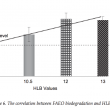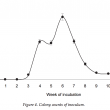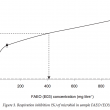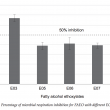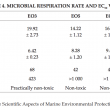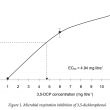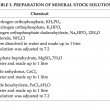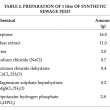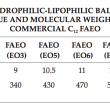Journal of Oil Palm Research Vol. 32 (4) December 2020, p. 665-673
ECOTOXICOLOGICAL BEHAVIOUR OF POORLY WATER SOLUBLE FATTY ALCOHOL ETHOXYLATES IN FRESHWATER ENVIRONMENT
DOI: https://doi.org/10.21894/jopr.2020.0051
Received: 17 October2019 Accepted: 13 February 2020 Published Online: 28 August 202
Fatty alcohol ethoxylates (FAEO) are widely used for a wide range of applications. Due to their excessive and widespread use, the ecotoxicological behaviour of FAEO in aquatic environment is crucial in managing the environmental sustainability. The objective of this study is to determine the ecotoxicology behaviour, i.e. biodegradation and ecotoxicity, of poorly water soluble lauryl alcohol ethoxylates (C12) with different ethoxylate numbers, i.e. EO3, EO5, EO6, EO7 and EO10. For ecotoxicity test, OECD 209, activated sludge, respiration inhibition test method was used. This method was selected as a rapid screening test to identify substances that have unfavourable influence on microorganisms in sewage treatment plant and also to identify non-inhibitory concentration of test substances applicable for biodegradation test. Meanwhile, the biodegradation test was performed using OECD 301C, MITI (I) (Ministry of International Trade and Industry, Japan) test method. The biodegradability of this surfactant was monitored for 28 days. The results of OECD 209 showed only FAEO (EO3) with a maximum concentration of 1000 mg litre–1 inhibited more than 50% respiration of activated sludge, while other FAEO samples inhibited less than 50% after 3 hr of exposure. The 3 hr of half maximal effective concentration (EC50) for FAEO (EO3) for activated sludge was 423 mg litre–1 while, for other FAEO samples was > 1000 mg litre–1. The toxicity effect decreased with increasing EO number. For biodegradation test, the results indicated that FAEO were readily biodegraded in OECD 301C where their biodegradability surpassed the 60% pass level as stated in the standard method and can be considered as readily biodegradable in the environment. As the EO chain length increased, the hydrophilic-lipophilic balance (HLB) of FAEO tended to increase while the hydrophobicity tended to decrease. The reduction in hydrophobicity level increases its solubility in water, thus promotes rapid biodegradation in aquatic environment.
KEYWORDS:FIGURES & TABLES:
* Malaysian Palm Oil Board,
6 Persiaran Institusi, Bandar Baru Bangi,
43000 Kajang, Selangor, Malaysia.
E-mail: siti.afida@mpob.gov.my
